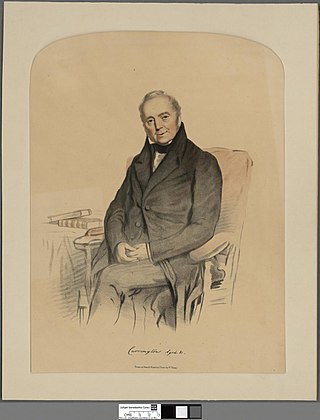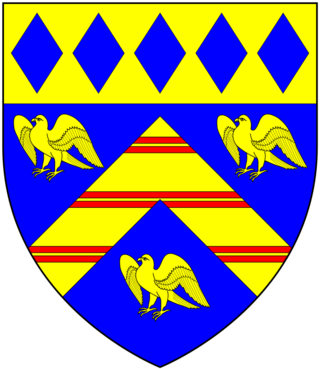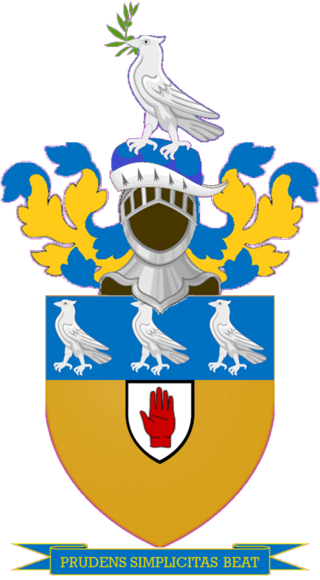
Earl Grey is a title in the peerage of the United Kingdom. It was created in 1806 for General Charles Grey, 1st Baron Grey. In 1801, he was given the title Baron Grey of Howick in the County of Northumberland, and in 1806 he was created Viscount Howick in the County of Northumberland, at the same time as he was given the earldom. A member of the prominent Grey family of Northumberland, Earl Grey was the third son of Sir Henry Grey, 1st Baronet of Howick.

Viscount Scarsdale, of Scarsdale in Derbyshire, is a title in the Peerage of the United Kingdom. It was created in 1911 for the prominent Conservative politician and former Viceroy of India George Curzon, 1st Baron Curzon of Kedleston, who was created Earl Curzon of Kedleston at the same time and was later made Marquess Curzon of Kedleston.

Baron Carrington is a title that has been created three times, once in the Peerage of England, once in the Peerage of Ireland and once in the Peerage of Great Britain.

Baron Daresbury, of Walton in the County of Chester, is a title in the Peerage of the United Kingdom. It was created on 21 June 1927 for Sir Gilbert Greenall, 2nd Baronet by King George V. The Baronetcy, of Walton Hall in the County of Chester, was created in the Baronetage of the United Kingdom on 22 February 1876 for his father Gilbert Greenall, who was head of the family brewing business and also represented Warrington in the House of Commons as a Conservative. As of 2015 the titles are held by the first Baron's great-grandson, the fourth Baron, who succeeded his father in 1996. The former seat of the Greenall family was Walton Hall near Warrington, Cheshire. However, the house was sold in 1941. The fourth Lord Daresbury was based at Hall Lane Farm on the Daresbury estate, home of the Creamfields music festival.

Baron Savile, of Rufford in the County of Nottingham, is a title in the Peerage of the United Kingdom. It was created in 1888 for the diplomat Sir John Savile. He was the eldest of the five illegitimate children of John Lumley-Savile, 8th Earl of Scarbrough, and the grandson of John Lumley-Savile, 7th Earl of Scarbrough. The latter was the fourth of the seven sons of Richard Lumley-Saunderson, 4th Earl of Scarbrough, and his wife Barbara, sister and heiress of the politician Sir George Savile, 8th and last Baronet, of Thornhill, who bequeathed the substantial Savile estates in Yorkshire and Nottinghamshire to his nephew the Hon. Richard Lumley-Saunderson, later 6th Earl of Scarbrough. On his death the estates passed to his younger brother, the aforementioned seventh Earl, and then to his son the eighth Earl. The latter bequeathed the estates to his second natural son Captain Henry Lumley-Savile. When he died they passed to his younger brother Augustus William Lumley-Savile (1829–1887) and then to his eldest brother, the aforementioned John Savile, who was created Baron Savile the following year.

Baron Broadbridge, of Brighton in the County of Sussex, is a title in the Peerage of the United Kingdom. It was created in 1945 for the Conservative politician Sir George Broadbridge, 1st Baronet. He had already been created a Baronet, of Wargrave Place in the County of Berkshire, on 22 November 1937. The title descended from father to son until the death of his grandson, the third Baron, in 2000. The late Baron was succeeded by his first cousin, who became the fourth holder of the titles. He was the son of Hugh Trevor Broadbridge, third son of the first Baron. He was in turn succeeded by his only son, Richard, a retired air vice-marshal who was honorary surgeon to the Queen, in 2020.

Baron Carnock, of Carnock in the County of Stirling, is a title in the Peerage of the United Kingdom. It was created in 1916 for the former Permanent Under-Secretary in the Foreign Office, Sir Arthur Nicolson, 11th Baronet.

Baron Rothschild, of Tring in the County of Hertfordshire, is a title in the Peerage of the United Kingdom. It was created in 1885 for Sir Nathan Rothschild, 2nd Baronet, a member of the Rothschild banking family. He was the first Jewish member of the House of Lords not to have previously converted to Christianity. The current holder of the title is Nathaniel Rothschild, 5th Baron Rothschild, who inherited the barony in February 2024.

Baron Roborough, of Maristow in the County of Devon, is a title in the Peerage of the United Kingdom. It was created on 24 January 1938 for Sir Henry Lopes, 4th Baronet. He had earlier represented Grantham, Lincolnshire, in Parliament as a Conservative. The Baronetcy, of Maristow House in the County of Devon, had been created in the Baronetage of the United Kingdom on 1 November 1805 for Manasseh Masseh Lopes, a member of a wealthy family of Portuguese Jewish origin, with special remainder to his nephew Ralph Franco, son of his sister Maria. Manasseh Masseh Lopes converted to Christianity in 1802, and later represented Evesham, in Worcestershire, Barnstaple in Devon, and Westbury in Somerset, in Parliament. However, in 1819 he was twice convicted of bribing the voters in both Barnstaple and Grampound in order to be elected to Parliament, and was sentenced to imprisonment and heavy fines. He was also unseated by the House of Commons, but after his release from prison he nonetheless got elected for Westbury, a pocket borough which he controlled to a great extent.

There have been two baronetcies created for persons with the surname Arthur, both in the Baronetage of the United Kingdom. As of 2014 both creations are extant.
Baron Harvey of Tasburgh, of Tasburgh in the County of Norfolk, is a title in the Peerage of the United Kingdom. It was created on 3 July 1954 for the diplomat Sir Oliver Harvey on his retirement as British Ambassador to France. In November the same year he also succeeded his half-brother as fourth Baronet of Crown Point.
The Pryke Baronetcy, of Wanstead in the County of Essex, is a title in the Baronetage of the United Kingdom. It was created on 3 November 1926 for William Robert Pryke. He was Chairman of Pryke & Palmer Ltd, iron and hardware merchants, and served as Lord Mayor of London from 1925 to 1926.

The Bruce-Gardner Baronetcy, of Frilford in the County of Berkshire, is a title in the Baronetage of the United Kingdom. It was created on 12 February 1945 for Charles Bruce-Gardner. He was Industrial Advisor to the Governor of the Bank of England from 1930 to 1938 and Chairman of the Society of British Aircraft Constructors from 1938 to 1943.
There have been three baronetcies created for persons with the surname Everard, one in the Baronetage of Ireland, one in the Baronetage of England and one in the Baronetage of the United Kingdom. Only one creation is extant as of 2010.

The Crisp Baronetcy, of Bungay in the County of Suffolk, is a title in the Baronetage of the United Kingdom. It was created on 5 February 1913 for the lawyer and microscopist Sir Frank Crisp.
The Roll Baronetcy, of The Chestnuts in Wanstead in the County of Essex, was a title in the Baronetage of the United Kingdom. It was created on 4 November 1921 for James Roll, Chairman of Pearl Assurance Co Ltd and Lord Mayor of London from 1920 to 1921. The title became extinct on the death of the fourth Baronet in 1998.
There have been three baronetcies created for persons with the surname Wiseman, all in the Baronetage of England. Only one creation is extant as of 2008.

The Frederick Baronetcy, of Burwood House in the County of Surrey, is a title in the Baronetage of Great Britain. It was created on 10 June 1723 for John Frederick of Burwood House in the southern half of Walton-on-Thames which later became Hersham.

The Buckworth, later Buckworth-Herne, later Buckworth-Herne-Soame Baronetcy, of Sheen in the County of Surrey, is a title in the Baronetage of England. It was created on 1 April 1697 for John Buckworth, High Sheriff of London in 1704. The second Baronet sat as Member of Parliament for Weobley. The third Baronet was Assistant Gentleman Usher to George II. The fifth Baronet was Gentleman-Pensioner and Exon of the Guard during the reign of George III. He married Anne, daughter of Paston Herne, of Haveringland Hall, Norfolk, and assumed by Royal licence the additional surname of Herne. The sixth Baronet assumed in 1806 by Royal licence the additional surname of Soame in compliance with the will of Sir Peter Soame, 4th Baronet, of Thurlow. The ninth Baronet was a member of the Shropshire County Council.

Sir Charles Albert Batho, 1st Baronet was Lord Mayor of London from 1927 to 1928.













